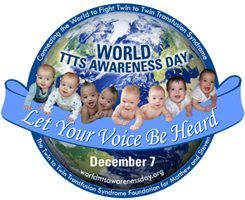Last updated on November 25th, 2023 at 11:24 am
Do you know what TTTS is? As a parent of multiples, you should. TTTS is Twin To Twin Transfusion Syndrome. This possibly fatal pregnancy related issue is a disease of the placenta (or afterbirth) that affects identical twin pregnancies.
By just knowing what TTTS is, you’ll be able to enlighten any other pregnant moms of multiples you may know, especially if they are carrying identicals, and potentially save lives. A few more facts you should know courtesy of the World TTTS Awareness Day
- TTTS affects identical twins (or higher multiple gestations), who share a common monochorionic placenta.
- The shared placenta contains abnormal blood vessels, which connect the umbilical cords and circulations of the twins.
- The common placenta may also be shared unequally by the twins, and one twin may have a share too small to provide the necessary nutrients to grow normally or even survive.
- The events in pregnancy that lead to TTTS – the timing of the twinning event, the number and type of connecting vessels, and the way the placenta is shared by the twins are all random events that have no primary prevention (see section on The Monochorionic Placenta), is not hereditary or genetic, nor is it caused by anything the parents did or did not do. TTTS can happen to anyone.
Organizations like Fetal Hope and TTTS Foundation help to make a difference. If you can, feel free to choose TODAY to make a small donation.
If you are currently pregnant with identical twins. Here are some questions you need to ask your doctor to ensure that you and your babies are out of harms way of TTTS according to World TTTS Awareness Day.
What Is the Largest Vertical Pocket of Amniotic Fluid in Each Baby’s Sac?
In normal twins, the deepest pocket of amniotic fluid should be around 3-8cm. When thefluid is greater than 8cm (polyhydramnious) and less then 2cm (oligohydramnios), thebabies have Stage I TTTS. The fluid level differences are distressing to see, but are thefindings most likely to change with treatments such as horizontal rest and nutritionalsupplements. You can determine the severity of TTTS to some degree, by watching whatthese numbers are, and how much they vary from the normal range. This information canhelp you to know when treatment may be needed and why, and gives you a tool to helpmake these decisions.There are varying opinions as to the number where an amniocentesis should be done.Some experts are wary about putting a needle into the uterus, there are some risks, and soit should be done for a good reason. In TTTS pregnancies genetic abnormalities areextremely rare, so it does not make sense to do an amniocentesis for genetic reasons alone.It may also not make sense to do amnioreductions of small volumes (less than a liter), whichis often the case if the deepest pocket measures 8-9cm or less. In higher stages of TTTS(III-IV), placental laser surgery is becoming the preferred treatment. Here the excessamniotic fluid is actually required to perform the operation, and should not be removed untilthe surgery itself. TTTS after the laser cutoff (over 25 weeks of pregnancy) will be treatedwith amniocentesis when necessary.
Can You See the Urinary Bladder of the Donor Baby?
The baby’s bladder is visible on ultrasound when it contains urine. Urine is the main source of amniotic fluid. If it cannot be visualized within 30 minutes, or if the donor baby has no or little amniotic fluid, its blood volume may be too low (from transfusion into the recipient) to perfuse the kidneys enough to urinate. Recipients always have larger than normal bladders in TTTS. If the ultrasound finds a visible bladder and a 2cm or more pocket, this much betternews for the donor. These findings will help give you some perspective on the donor’s statusand the seriousness of TTTS.
What Are the Weights of the Babies in Grams? (Every 2-3 Weeks)
The relative size differences between monochorionic twins with TTTS (or in general) arebest calculated with grams (typically 3 digits) rather than ounces (3 digits rounded to 1 or 2).The percent difference is calculated by taking weight difference in grams, and dividing that number by the weight of the larger baby. If the weight discordance is 20% or more, it isconsidered significant. The most likely cause of the discordance in monochorionic twins is unequal sharing of their single placenta. The smaller a placenta portion, the less nutrients are delivered to that baby. Small placentas are often associated with two vessel or velamentous umbilical cords, and Doppler flow abnormalities. Since the twins’ shares of the placenta are fixed from the beginning of the pregnancy, and cannot be improved upon, nutritional supplementation and horizontal rest may help maximize the supply of nutrients to the smaller twin and help it thrive
Are the Doppler Ultrasound Studies Normal for Both Babies?
The Doppler ultrasound demonstrates how blood is flowing through the umbilical cords and placentas of the babies. It shows how well their hearts are pumping the blood by color(similar to taking a blood pressure which uses sound to determine systolic and diastolic numbers). In TTTS, Doppler is used to study blood flow through the umbilical cords, through the middle cerebral artery to detect anemia in the donor, and in and around the recipient’s heart to detect stress or heart failure.Common abnormal Doppler studies in donor twins include absent diastolic flow in theumbilical cord (blood moves forward only when the heart is contracting), and reversediastolic flow in the cord (blood moves back toward the heart when the heart relaxes). Thesestudies are influenced by both the size of the transfusion and smaller sizes of a twin’splacenta share. Reverse diastolic flow is much more dangerous, and requires urgentdecision making regarding laser surgery or delivery, if feasible at the gestational age.Doppler studies are considered a routine part of monitoring complicated monochorionic twinpregnancy from about 15 weeks onward.
These are just some of the questions you should ask your doctor. For more visit the TTTS website.
Get the facts. Get Educated. STAY informed.









